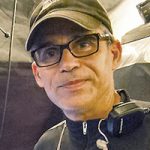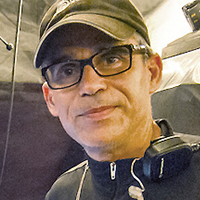When I was getting my start in the live sound business, I was, of course, always looking for a gig. However, even back then, I came across a few “opportunities” that I thought I’d better walk away from. Here are three that I remember, in more-or-less chronological order.
Gig One
In 1979, when I had just moved to Toronto to start my career, there were three main places where sound techs looking for work could look. One was the “Dramatic and Musical Talent” section in the Toronto Star’s classified section. Ninety percent of the ads were bands looking for musicians, but here and there you would find an ad looking for a “soundman” (and yes, most of us were male, although within a year or two I knew a few women mixers). The second and third places were the bulletin boards at the two biggest music stores in town, Steve’s Music and Long & McQuades.
It was likely from one of these sources that I got a call to go to a show bar on Yonge St (the main drag, and still kind of rough back then) and interview about a job mixing, you guessed it, a show band. My memory is a bit hazy, but I believe this was in the afternoon and the band was on stage rehearsing when I got there.
When I walked up to the console, there was a young person mixing, with the manager standing over his shoulder kibitzing. Now, I was only 18, but this fellow seemed young even to me.
In any case, when I got close enough to see what he had going on at the console, I immediately noticed that all the gain pots were way up and the faders way, way down … about an inch up from the bottom. And I thought to myself, “There’s too much wrong here. If I do get asked to mix, I’m going to have to undo all this and start over, and that’s probably going to cause some trouble.” So instead, I excused myself and left.
Gig Two
Sometime after that, I answered another ad and took the subway over to the east end to meet with a newly formed rock band. It was an early summer evening when I arrived. The band members were all living in an old house and rehearsing in the cramped, unfinished basement.
We all went down to the basement where I asked the band what kind of music they were into. The answer came back that they were into a bit of Stones, a bit of Zeppelin, a bit of Queen, a bit of Pink Floyd, etc. They then told me of their immediate plans and long-term goals, which were to “Go up north and pay our dues for six months, and then come back down here and hit the Toronto scene, hard!”
This was followed by them playing a couple of songs, excruciatingly loudly of course. I can’t really recall any back-and-forth that I had with them, although they must have asked me about my credentials, and I must have told them … something.
Then they asked me if I wanted to hear one of their “originals,” and I said “sure,” so we all trooped upstairs where the leader hit play on a TEAC 4-track reel-to-reel that spewed out a “song” that went on for probably seven minutes and sounded like … a bit of Stones, a bit of Zeppelin, a bit of Queen, a bit of Pink Floyd, etc. I said I would think about it.
On my way out, I got a strong whiff of model airplane glue – and saw no evidence of anyone building a model between stinging lead breaks and thunderous drum fills. Once outside, I took a look around and realized that I was in kind of a sketchy neighborhood, and that I didn’t see any people around. I remember that being a rather long, anxious walk back up to the subway.
Gig Three
Some years later, I was in my mid-20s, and had already done my two years of bar bands and even worked at a sound company for four years, having managed their manufacturing department for the last three of those. I was now freelancing and part of a five-person sound cooperative where we shared gigs and gear (or at least tried to, it fell apart after a few years). This would have been around 1985-86.
Somehow, a call came in that a west coast band that was in mid-tour, in support of their new record, was looking for a sound person to fill in for their current sound tech for the return leg of the tour. They were playing at the University of Toronto that night, I think doing Ottawa with Montreal next and then heading back west.
The other bit of intel that I heard before I went to see them was that they were “sampling the kick drum sound from the album.” Sampling was just starting to be a really big new thing in the mid-80s. I hadn’t done any of it and I was kind of intimidated by the idea.
Nonetheless, I plucked up my courage and went to meet them while they were setting up. Their sound person met me and introduced me to the band, who immediately welcomed me and asked me if I knew that they were sampling the kick drum sound from the record? So, it was a really big deal for them.
I then went back to front of house (this was at a pub) with the sound person, who proceeded to show me how the sampling set-up worked. Which was … the sample of the “actual kick drum sound that they used on the record” … which had been produced by some “name” producer … that was stored … on a cassette tape! This was then played into a Korg 2000 sampling delay, every day, at setup (and presumably after any power interruption).
The kick drum was miked, and this input went into channel 1 of the mixer, a Soundcraft, maybe a 400B. The kick input on channel 1 was used, via the insert send, solely to trigger the Korg delay, the output of which was fed into a Klark-Teknik DN-27 EQ, which then fed a Brooke-Siren FDS-340 three-way crossover.
The low and mid outputs of the crossover went into channels 2 and 3, respectively, on the desk. The high output went through a one-knob Loft noise gate (to get rid of the hiss!) and then into channel 4 on the console … so the kick drum sample was spread across three channels on the desk.
The rest of the drum kit was miked in the usual way, as was the rest of the band. Now, I think that I had to leave before the actual sound check but promised to come back for the show that night.
The Finish Line
Which I did, with one of my colleagues from the co-op and his girlfriend. We got drinks and waited for the band to start, all quite intrigued about what this awesome kick drum would sound like.
Well, when the band started, the kick drum sounded like 62, no, maybe 63 different kinds of awful. All these years later, I’m still trying to come up with a possible “good” explanation for it, like it just wasn’t my style of music, or different courses for different horses or whatever, but my recollection is that it just sounded bad – really, really bad. I can’t even describe it … it didn’t sound like anything really … just a lot of low frequency … stuff.
I’ve neglected to mention that the “plan” was that if I took the gig, I would “understudy” the existing sound person for the next two shows and then take over from there. Listening to that kick drum, I thought to myself, “There is no way that I will be able to pretend to use that setup for two gigs before I dial in the real kick drum mic and replicate whatever the actual kick drum sound for the record they’re trying to reproduce with that horrible sample!”
So, once again, I excused myself and left.















